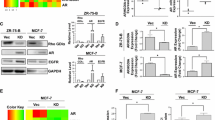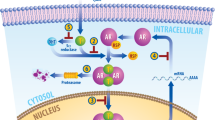Abstract
Although the androgen receptor (AR) is a known clinical target in prostate cancer, little is known about its possible role in breast cancer. We have investigated the role of AR expression in human breast cancer in response to treatment with the antiestrogen tamoxifen. Resistance to tamoxifen is a major problem in treating women with breast cancer. By gene expression profiling, we found elevated AR and reduced estrogen receptor (ER) α mRNA in tamoxifen-resistant tumors. Exogenous overexpression of AR rendered ERα-positive MCF-7 breast cancer cells resistant to the growth-inhibitory effects of tamoxifen in anchorage-independent growth assays and in xenograft studies in athymic nude mice. AR-overexpressing cells remained sensitive to growth stimulation with dihydrotestosterone. Treatment with the AR antagonist Casodex™ (bicalutamide) reversed this resistance, demonstrating the involvement of AR signaling in tamoxifen resistance. In AR-overexpressing cells, tamoxifen induced transcriptional activation by ERα that could be blocked by Casodex, suggesting that AR overexpression enhances tamoxifen’s agonistic properties. Our data suggest a role for AR overexpression as a novel mechanism of hormone resistance, so that AR may offer a new clinical therapeutic target in human breast cancers.




Similar content being viewed by others
Abbreviations
- AR:
-
Androgen receptor
- EGF:
-
Epidermal growth factor
- EGFR:
-
Epidermal growth factor receptor
- ERα:
-
Estrogen receptor alpha
- PR:
-
Progesterone receptor
- qRT-PCR:
-
Quantitative reverse transcriptase-polymerase chain reaction
References
Brünner N, Yee D, Kern FG, Spang-Thomsen M, Lippman ME, Cullen KJ (1993) Effect of endocrine therapy on growth of T61 human breast cancer xenografts is directly correlated to a specific down-regulation of insulin-like growth factor II (IGF-II). Eur J Cancer 29A(4):562–569. doi:10.1016/S0959-8049(05)80152-2
Lykkesfeldt AE, Madsen MW, Briand P (1994) Altered expression of estrogen-regulated genes in a tamoxifen-resistant and ICI 164, 384 and ICI 182, 780 sensitive human breast cancer cell line, MCF-7/TAMR-1. Cancer Res 54(6):1587–1595
Cui Y, Parra I, Zhang M, Hilsenbeck SG, Tsimelzon A, Furukawa T, Horii A, Zhang ZY, Nicholson RI, Fuqua SA (2006) Elevated expression of mitogen-activated protein kinase phosphatase 3 in breast tumors: a mechanism of tamoxifen resistance. Cancer Res 66(11):5950–5959. doi:10.1158/0008-5472.CAN-05-3243
Takimoto GS, Graham JD, Jackson TA, Tung L, Powell RL, Horwitz LD, Horwitz KB (1999) Tamoxifen resistant breast cancer: coregulators determine the direction of transcription by antagonist-occupied steroid receptors. J Steroid Biochem Mol Biol 69(1–6):45–50
Nicholson RI, Gee JM (2000) Oestrogen and growth factor cross-talk and endocrine insensitivity and acquired resistance in breast cancer. Br J Cancer 82(3):501–513. doi:10.1054/bjoc.1999.0954
Osborne CK, Shou J, Massarweh S, Schiff R (2005) Crosstalk between estrogen receptor and growth factor receptor pathways as a cause for endocrine therapy resistance in breast cancer. Clin Cancer Res 11(2 Pt 2):865s–870s
Benz CC, Scott GK, Sarup JC, Johnson RM, Tripathy D, Coronado E, Shepard HM, Osborne CK (1992) Estrogen-dependent, tamoxifen-resistant tumorigenic growth of MCF-7 cells transfected with HER2/neu. Breast Cancer Res Treat 24(2):85–95. doi:10.1007/BF01961241
Hutcheson IR, Knowlden JM, Madden TA, Barrow D, Gee JM, Wakeling AE, Nicholson RI (2003) Oestrogen receptor-mediated modulation of the EGFR/MAPK pathway in tamoxifen-resistant MCF-7 cells. Breast Cancer Res Treat 81(1):81–93. doi:10.1023/A:1025484908380
Hopp TA, Weiss HL, Hilsenbeck SG, Cui Y, Allred DC, Horwitz KB, Fuqua SA (2004) Breast cancer patients with progesterone receptor PR-A-rich tumors have poorer disease-free survival rates. Clin Cancer Res 10(8):2751–2760. doi:10.1158/1078-0432.CCR-03-0141
Lea OA, Kvinnsland S, Thorsen T (1989) Improved measurement of androgen receptors in human breast cancer. Cancer Res 49(24 Pt 1):7162–7167
Schippinger W, Regitnig P, Dandachi N, Wernecke KD, Bauernhofer T, Samonigg H, Moinfar F (2006) Evaluation of the prognostic significance of androgen receptor expression in metastatic breast cancer. Virchows Arch 449(1):24–30. doi:10.1007/s00428-006-0213-6
Ando S, De Amicis F, Rago V, Carpino A, Maggiolini M, Panno ML, Lanzino M (2002) Breast cancer: from estrogen to androgen receptor. Mol Cell Endocrinol 193(1–2):121–128. doi:10.1016/S0303-7207(02)00105-3
Panet-Raymond V, Gottlieb B, Beitel LK, Pinsky L, Trifiro MA (2000) Interactions between androgen and estrogen receptors and the effects on their transactivational properties. Mol Cell Endocrinol 167(1–2):139–150. doi:10.1016/S0303-7207(00)00279-3
Mellinghoff IK, Vivanco I, Kwon A, Tran C, Wongvipat J, Sawyers CL (2004) HER2/neu kinase-dependent modulation of androgen receptor function through effects on DNA binding and stability. Cancer Cell 6(5):517–527. doi:10.1016/j.ccr.2004.09.031
Migliaccio A, Di Domenico M, Castoria G, Nanayakkara M, Lombardi M, de Falco A, Bilancio A, Varricchio L, Ciociola A, Auricchio F (2005) Steroid receptor regulation of epidermal growth factor signaling through Src in breast and prostate cancer cells: steroid antagonist action. Cancer Res 65(22):10585–10593. doi:10.1158/0008-5472.CAN-05-0912
Fuqua SAW, Wiltschke C, Zhang QX, Borg A, Castles CG, Friedrichs WE, Hopp T, Hilsenbeck S, Mohsin S, O’Connell P, Allred DC (2000) A hypersensitive estrogen receptor-α mutation in premalignant breast lesions. Cancer Res 60(15):4026–4029
Zhao HH, Herrera RE, Coronado-Heinsohn E, Yang MC, Ludes-Meyers JH, Seybold-Tilson KJ, Nawaz Z, Yee D, Barr FG, Diab SG, Brown PH, Fuqua SA, Osborne CK (2001) Forkhead homologue in rhabdomyosarcoma functions as a bifunctional nuclear receptor-interacting protein with both coactivator and corepressor functions. J Biol Chem 276(30):27907–27912. doi:10.1074/jbc.M104278200
Agoulnik IU, Krause WC, Bingman WE 3rd, Rahman HT, Amrikachi M, Ayala GE, Weigel NL (2003) Repressors of androgen and progesterone receptor action. J Biol Chem 278(33):31136–31148. doi:10.1074/jbc.M305153200
Lower EE, Glass EL, Bradley DA, Blau R, Heffelfinger S (2005) Impact of metastatic estrogen receptor and progesterone receptor status on survival. Breast Cancer Res Treat 90(1):65–70. doi:10.1007/s10549-004-2756-z
Hull DF, Clark GM, Osborne CK, Chamness GC, Knight WAI, McGuire WL (1983) Multiple estrogen receptor assays in human breast cancer. Cancer Res 43:413–416
Kuukasjarvi T, Kononen J, Helin H, Holli K, Isola J (1996) Loss of estrogen receptor in recurrent breast cancer is associated with poor response to endocrine therapy. J Clin Oncol 14:2584
Shaw LE, Sadler AJ, Pugazhendhi D, Darbre PD (2006) Changes in oestrogen receptor-alpha and -beta during progression to acquired resistance to tamoxifen and fulvestrant (Faslodex, ICI 182, 780) in MCF7 human breast cancer cells. J Steroid Biochem Mol Biol 99(1):19–32. doi:10.1016/j.jsbmb.2005.11.005
Fradet Y (2004) Bicalutamide (Casodex) in the treatment of prostate cancer. Expert Rev Anticancer Ther 4(1):37–48. doi:10.1586/14737140.4.1.37
Birrell SN, Bentel JM, Hickey TE, Ricciardelli C, Weger MA, Horsfall DJ, Tilley WD (1995) Androgens induce divergent proliferative responses in human breast cancer cell lines. J Steroid Biochem Mol Biol 52(5):459–467. doi:10.1016/0960-0760(95)00005-K
Knowlden JM, Hutcheson IR, Jones HE, Madden T, Gee JM, Harper ME, Barrow D, Wakeling AE, Nicholson RI (2003) Elevated levels of epidermal growth factor receptor/c-erbB2 heterodimers mediate an autocrine growth regulatory pathway in tamoxifen-resistant MCF-7 cells. Endocrinology 144(3):1032–1044. doi:10.1210/en.2002-220620
Osborne CK, Bardou V, Hopp TA, Chamness GC, Hilsenbeck SG, Fuqua SA, Wong J, Allred DC, Clark GM, Schiff R (2003) Role of the estrogen receptor coactivator AIB1 (SRC-3) and HER-2/neu in tamoxifen resistance in breast cancer. J Natl Cancer Inst 95(5):353–361
Shou J, Massarweh S, Osborne CK, Wakeling AE, Ali S, Weiss H, Schiff R (2004) Mechanisms of tamoxifen resistance: increased estrogen receptor-HER2/neu cross-talk in ER/HER2-positive breast cancer. J Natl Cancer Inst 96(12):926–935
Frasor J, Danes JM, Komm B, Chang KC, Lyttle CR, Katzenellenbogen BS (2003) Profiling of estrogen up- and down-regulated gene expression in human breast cancer cells: insights into gene networks and pathways underlying estrogenic control of proliferation and cell phenotype. Endocrinology 144(10):4562–4574. doi:10.1210/en.2003-0567
Wijayaratne AL, McDonnell DP (2001) The human estrogen receptor-alpha is a ubiquitinated protein whose stability is affected differentially by agonists, antagonists, and selective estrogen receptor modulators. J Biol Chem 276(38):35684–35692. doi:10.1074/jbc.M101097200
Kurokawa H, Lenferink AE, Simpson JF, Pisacane PI, Sliwkowski MX, Forbes JT, Arteaga CL (2000) Inhibition of HER2/neu (erB-2) and mitogen-activated protein kinases enhances tamoxifen action against HER2-overxpressing, tamoxifen-resistant breast cancer cells. Cancer Res 60:5887–5894
Gee JM, Robertson JF, Ellis IO, Nicholson RI (2001) Phosphorylation of ERK1/2 mitogen-activated protein kinase is associated with poor response to anti-hormonal therapy and decreased patient survival in clinical breast cancer. Int J Cancer 95(4):247–254. doi:10.1002/1097-0215(20010720)95:4<247::AID-IJC1042>3.0.CO;2-S
Peterziel H, Mink S, Schonert A, Becker M, Klocker H, Cato AC (1999) Rapid signalling by androgen receptor in prostate cancer cells. Oncogene 18(46):6322–6329. doi:10.1038/sj.onc.1203032
Ryan PD, Goss PE (2006) Adjuvant hormonal therapy in peri- and postmenopausal breast cancer. Oncologist 11(7):718–731. doi:10.1634/theoncologist.11-7-718
Houston SJ, Plunkett TA, Barnes DM, Smith P, Rubens RD, Miles DW (1999) Overexpression of c-erbB2 is an independent marker of resistance to endocrine therapy in advanced breast cancer. Br J Cancer 79(7–8):1220–1226. doi:10.1038/sj.bjc.6690196
Berry DA, Muss HB, Thor AD, Dressler L, Liu ET, Broadwater G, Budman DR, Henderson IC, Barcos M, Hayes D, Norton L (2000) HER-2/neu and p53 expression versus tamoxifen resistance in estrogen receptor-positive, node-positive breast cancer. J Clin Oncol 18(20):3471–3479
Buchanan G, Birrell SN, Peters AA, Bianco-Miotto T, Ramsay K, Cops EJ, Yang M, Harris JM, Simila HA, Moore NL, Bentel JM, Ricciardelli C, Horsfall DJ, Butler LM, Tilley WD (2005) Decreased androgen receptor levels and receptor function in breast cancer contribute to the failure of response to medroxyprogesterone acetate. Cancer Res 65(18):8487–8496. doi:10.1158/0008-5472.CAN-04-3077
Bentel JM, Birrell SN, Pickering MA, Holds DJ, Horsfall DJ, Tilley WD (1999) Androgen receptor agonist activity of the synthetic progestin, medroxyprogesterone acetate, in human breast cancer cells. Mol Cell Endocrinol 154(1–2):11–20. doi:10.1016/S0303-7207(99)00109-4
Maggiolini M, Donze O, Jeannin E, Ando S, Picard D (1999) Adrenal androgens stimulate the proliferation of breast cancer cells as direct activators of estrogen receptor alpha. Cancer Res 59(19):4864–4869
Bhattacharyya RS, Krishnan AV, Swami S, Feldman D (2006) Fulvestrant (ICI 182, 780) down-regulates androgen receptor expression and diminishes androgenic responses in LNCaP human prostate cancer cells. Mol Cancer Ther 5(6):1539–1549. doi:10.1158/1535-7163.MCT-06-0065
Ingle JN, Twito DI, Schaid DJ, Cullinan SA, Krook JE, Mailliard JA, Tschetter LK, Long HJ, Gerstner JG, Windschitl HE et al (1991) Combination hormonal therapy with tamoxifen plus fluoxymesterone versus tamoxifen alone in postmenopausal women with metastatic breast cancer. An updated analysis. Cancer 67(4):886–891. doi:10.1002/1097-0142(19910215)67:4<886::AID-CNCR2820670405>3.0.CO;2-O
Nazareth LV, Weigel NL (1996) Activation of the human androgen receptor through a protein kinase A signaling pathway. J Biol Chem 271(33):19900–19907. doi:10.1074/jbc.271.33.19900
Agoulnik IU, Vaid A, Nakka M, Alvarado M, Bingman WE 3rd, Erdem H, Frolov A, Smith CL, Ayala GE, Ittmann MM, Weigel NL (2006) Androgens modulate expression of transcription intermediary factor 2, an androgen receptor coactivator whose expression level correlates with early biochemical recurrence in prostate cancer. Cancer Res 66(21):10594–10602. doi:10.1158/0008-5472.CAN-06-1023
Ochiai I, Matsuda K, Nishi M, Ozawa H, Kawata M (2004) Imaging analysis of subcellular correlation of androgen receptor and estrogen receptor alpha in single living cells using green fluorescent protein color variants. Mol Endocrinol 18(1):26–42. doi:10.1210/me.2002-0262
Eeckhoute J, Carroll JS, Geistlinger TR, Torres-Arzayus MI, Brown M (2006) A cell-type-specific transcriptional network required for estrogen regulation of cyclin D1 and cell cycle progression in breast cancer. Genes Dev 20(18):2513–2526. doi:10.1101/gad.1446006
Vendrell JA, Bieche I, Desmetz C, Badia E, Tozlu S, Nguyen C, Nicolas JC, Lidereau R, Cohen PA (2005) Molecular changes associated with the agonist activity of hydroxy-tamoxifen and the hyper-response to estradiol in hydroxy-tamoxifen-resistant breast cancer cell lines. Endocr Relat Cancer 12(1):75–92. doi:10.1677/erc.1.00899
Hodges LC, Cook JD, Lobenhofer EK, Li L, Bennett L, Bushel PR, Aldaz CM, Afshari CA, Walker CL (2003) Tamoxifen functions as a molecular agonist inducing cell cycle-associated genes in breast cancer cells. Mol Cancer Res 1(4):300–311
Stendahl M, Kronblad A, Ryden L, Emdin S, Bengtsson NO, Landberg G (2004) Cyclin D1 overexpression is a negative predictive factor for tamoxifen response in postmenopausal breast cancer patients. Br J Cancer 90(10):1942–1948. doi:10.1038/sj.bjc.6601831
Acknowledgments
This work was supported by NIH grants P01-CA30195 and P50-CA58183 (S. A. W. Fuqua), Department of Defense grant DAMD 07-73-220 (J. Thirugnansampanthan), Department of Defense grant DAMD 17-99-01-9399 (Y. Cui), Department of Defense grant DAMD 17-03-0417 (M. Herynk), and NIH T32 CA90221 (J. Selever). S. A. W. Fuqua and N. L. Weigel were also supported by a pilot grant from the Dan L. Duncan Cancer Center at Baylor College of Medicine for this work. We thank Robin Sample for her excellent administrative assistance.
Author information
Authors and Affiliations
Corresponding author
Additional information
The authors F. De Amicis and J. Thirugnansampanthan are co-first authors for this Article.
Rights and permissions
About this article
Cite this article
De Amicis, F., Thirugnansampanthan, J., Cui, Y. et al. Androgen receptor overexpression induces tamoxifen resistance in human breast cancer cells. Breast Cancer Res Treat 121, 1–11 (2010). https://doi.org/10.1007/s10549-009-0436-8
Received:
Accepted:
Published:
Issue Date:
DOI: https://doi.org/10.1007/s10549-009-0436-8




